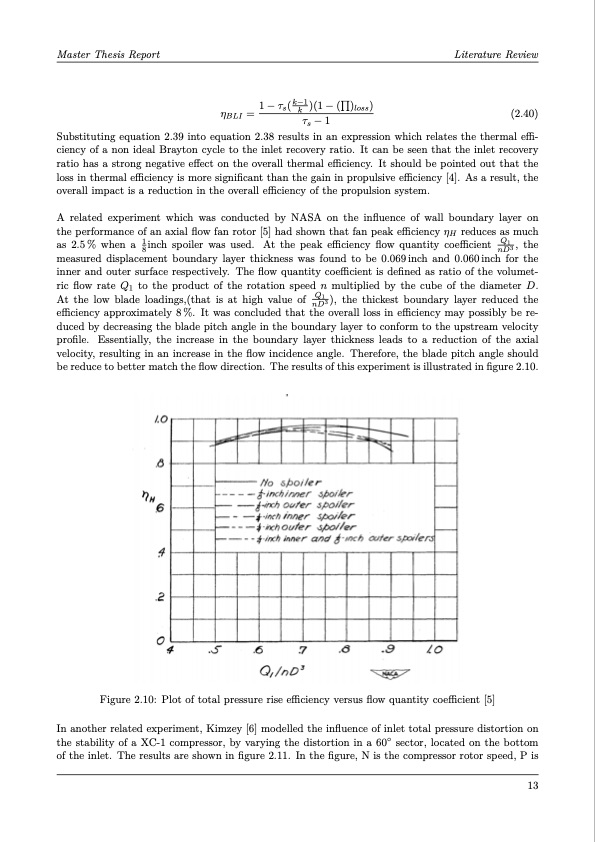
PDF Publication Title:
Text from PDF Page: 026
Master Thesis Report Literature Review 1 − τs(k−1)(1 − ()loss) ηBLI = k τs − 1 (2.40) Substituting equation 2.39 into equation 2.38 results in an expression which relates the thermal effi- ciency of a non ideal Brayton cycle to the inlet recovery ratio. It can be seen that the inlet recovery ratio has a strong negative effect on the overall thermal efficiency. It should be pointed out that the loss in thermal efficiency is more significant than the gain in propulsive efficiency [4]. As a result, the overall impact is a reduction in the overall efficiency of the propulsion system. A related experiment which was conducted by NASA on the influence of wall boundary layer on the performance of an axial flow fan rotor [5] had shown that fan peak efficiency ηH reduces as much as 2.5% when a 1inch spoiler was used. At the peak efficiency flow quantity coefficient Q1 , the 8 nD3 measured displacement boundary layer thickness was found to be 0.069inch and 0.060inch for the inner and outer surface respectively. The flow quantity coefficient is defined as ratio of the volumet- ric flow rate Q1 to the product of the rotation speed n multiplied by the cube of the diameter D. At the low blade loadings,(that is at high value of Q1 ), the thickest boundary layer reduced the nD3 efficiency approximately 8 %. It was concluded that the overall loss in efficiency may possibly be re- duced by decreasing the blade pitch angle in the boundary layer to conform to the upstream velocity profile. Essentially, the increase in the boundary layer thickness leads to a reduction of the axial velocity, resulting in an increase in the flow incidence angle. Therefore, the blade pitch angle should be reduce to better match the flow direction. The results of this experiment is illustrated in figure 2.10. Figure 2.10: Plot of total pressure rise efficiency versus flow quantity coefficient [5] In another related experiment, Kimzey [6] modelled the influence of inlet total pressure distortion on the stability of a XC-1 compressor, by varying the distortion in a 60◦ sector, located on the bottom of the inlet. The results are shown in figure 2.11. In the figure, N is the compressor rotor speed, P is 13PDF Image | Aerodynamic Design of the NASA Rotor 67 for Non Uniform Inflow

PDF Search Title:
Aerodynamic Design of the NASA Rotor 67 for Non Uniform InflowOriginal File Name Searched:
nasa-rotor-67.pdfDIY PDF Search: Google It | Yahoo | Bing
NFT (Non Fungible Token): Buy our tech, design, development or system NFT and become part of our tech NFT network... More Info
IT XR Project Redstone NFT Available for Sale: NFT for high tech turbine design with one part 3D printed counter-rotating energy turbine. Be part of the future with this NFT. Can be bought and sold but only one design NFT exists. Royalties go to the developer (Infinity) to keep enhancing design and applications... More Info
Infinity Turbine IT XR Project Redstone Design: NFT for sale... NFT for high tech turbine design with one part 3D printed counter-rotating energy turbine. Includes all rights to this turbine design, including license for Fluid Handling Block I and II for the turbine assembly and housing. The NFT includes the blueprints (cad/cam), revenue streams, and all future development of the IT XR Project Redstone... More Info
Infinity Turbine ROT Radial Outflow Turbine 24 Design and Worldwide Rights: NFT for sale... NFT for the ROT 24 energy turbine. Be part of the future with this NFT. This design can be bought and sold but only one design NFT exists. You may manufacture the unit, or get the revenues from its sale from Infinity Turbine. Royalties go to the developer (Infinity) to keep enhancing design and applications... More Info
Infinity Supercritical CO2 10 Liter Extractor Design and Worldwide Rights: The Infinity Supercritical 10L CO2 extractor is for botanical oil extraction, which is rich in terpenes and can produce shelf ready full spectrum oil. With over 5 years of development, this industry leader mature extractor machine has been sold since 2015 and is part of many profitable businesses. The process can also be used for electrowinning, e-waste recycling, and lithium battery recycling, gold mining electronic wastes, precious metals. CO2 can also be used in a reverse fuel cell with nafion to make a gas-to-liquids fuel, such as methanol, ethanol and butanol or ethylene. Supercritical CO2 has also been used for treating nafion to make it more effective catalyst. This NFT is for the purchase of worldwide rights which includes the design. More Info
NFT (Non Fungible Token): Buy our tech, design, development or system NFT and become part of our tech NFT network... More Info
Infinity Turbine Products: Special for this month, any plans are $10,000 for complete Cad/Cam blueprints. License is for one build. Try before you buy a production license. May pay by Bitcoin or other Crypto. Products Page... More Info
| CONTACT TEL: 608-238-6001 Email: greg@infinityturbine.com | RSS | AMP |